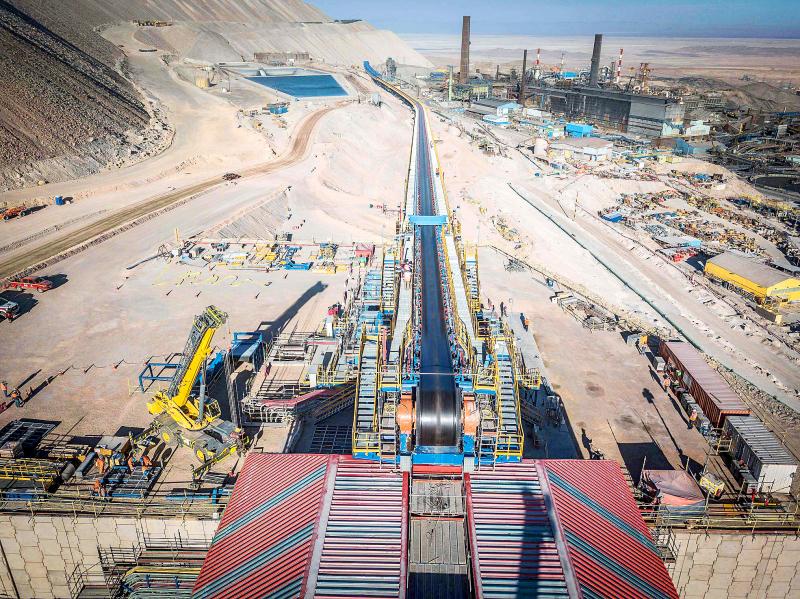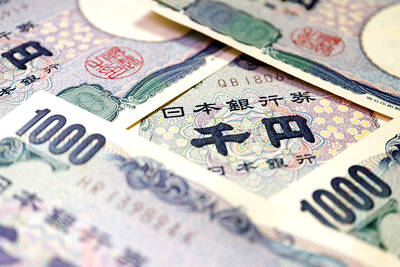With the price of copper reaching a 10-year high thanks in no small part to China’s insatiable appetite, Chile, the world’s leading producer, faces a “unique” opportunity, experts said.
Copper on Wednesday rose to US$4.21 per pound on the London Metal Exchange, meaning that it has doubled its price since March last year.
Experts say that its price, spurred by demand from China, could beat all records in the coming weeks, surpassing its previous high of US$4.60 in February 2011 and potentially rising above US$5 per pound.

Photo: AFP / CODELCO / Olivier Llaneza
“The intensity of consumption of primary materials in China has intensified due to the COVID-19 pandemic,” said Juan Carlos Guajardo, director of mining consulting company Plusmining.
China, which buys almost half of the world’s copper production, is trying to become the “true factory of the world,” he said.
On top of Chinese demand, copper purchases are also on the rise due to its use in renewable energy and electric mobility.
In addition, a weakened US dollar means that raw materials priced in the US currency are cheaper for investors using other currencies, and stimulus packages to reboot economies ravaged by the pandemic have flooded the global market with liquidity.
At the same time, there has been a reduction in investment in the supply side of the mining industry since the boom years of 2003 to 2013 — and the subsequent lack of new expansion plans of existing mines has resulted in less copper on the market and higher prices for Chile.
All in all, the conditions have created a favorable scenario for Chile’s main export.
Chile produces close to one-third of the world’s copper, and copper represents 10 to 15 percent of national GDP.
“The rise in the copper price gives Chile a unique opportunity to keep developing the mining sector, increase production capacity and thus meet the expected rising demand,” Chilean Minister of Mining Juan Carlos Jobet said.
The increase in price “could mobilize more investment in the mining sector and that could mean greater employment” during a year in which Chile would be hoping to return to economic growth after GDP last year fell by 6 percent due to the pandemic, Chilean Minister of Finance Rodrigo Cerda said.
Last year would have been a lot more painful for Chile had the copper industry been forced to shut down like many other sectors during a pandemic-imposed lockdown.
However, given that the main mining sites were far from the infection hot spots, the copper industry was spared the painful closures that hit commercial centers, restaurants, bars and movie theaters, among other businesses.
However, Chile must be wary of a rising supply in copper, said Marcela Vera, a researcher at the University of Santiago.
Given its use in renewable energies and potentially limited supplies, it would be counterproductive for Chile to produce greater amounts of copper that bring down prices when the metal could become so precious in the future.
“What Chile needs to do sovereignly is to generate a reduction in the offer so the prices adjust,” Vera said.
Increased production would lead to falling prices and a shorter lifespan for the metal.
“Copper is not a renewable product and it won’t be around for ever,” Vera said.

AI TALENT: No financial details were released about the deal, in which top Groq executives, including its CEO, would join Nvidia to help advance the technology Nvidia Corp has agreed to a licensing deal with artificial intelligence (AI) start-up Groq, furthering its investments in companies connected to the AI boom and gaining the right to add a new type of technology to its products. The world’s largest publicly traded company has paid for the right to use Groq’s technology and is to integrate its chip design into future products. Some of the start-up’s executives are leaving to join Nvidia to help with that effort, the companies said. Groq would continue as an independent company with a new chief executive, it said on Wednesday in a post on its Web

RESPONSE: The Japanese Ministry of Finance might have to intervene in the currency markets should the yen keep weakening toward the 160 level against the US dollar Japan’s chief currency official yesterday sent a warning on recent foreign exchange moves, after the yen weakened against the US dollar following Friday last week’s Bank of Japan (BOJ) decision. “We’re seeing one-directional, sudden moves especially after last week’s monetary policy meeting, so I’m deeply concerned,” Japanese Vice Finance Minister for International Affairs Atsushi Mimura told reporters. “We’d like to take appropriate responses against excessive moves.” The central bank on Friday raised its benchmark interest rate to the highest in 30 years, but Bank of Japan Governor Kazuo Ueda chose to keep his options open rather than bolster the yen,

Even as the US is embarked on a bitter rivalry with China over the deployment of artificial intelligence (AI), Chinese technology is quietly making inroads into the US market. Despite considerable geopolitical tensions, Chinese open-source AI models are winning over a growing number of programmers and companies in the US. These are different from the closed generative AI models that have become household names — ChatGPT-maker OpenAI or Google’s Gemini — whose inner workings are fiercely protected. In contrast, “open” models offered by many Chinese rivals, from Alibaba (阿里巴巴) to DeepSeek (深度求索), allow programmers to customize parts of the software to suit their

Global server shipments are expected to surge to 15 million units next year, from 4 million units this year, with artificial intelligence (AI) servers accounting for about 30 percent, driven by massive capital spending by major cloud service providers, the Market Intelligence and Consulting Institute (MIC) said on Thursday last week. Major cloud service providers — including Google’s parent company Alphabet Inc, Microsoft Corp, Amazon.com Inc and Meta Platforms Inc — are projected to budget US$450 million for capital expenditure next year, up from US$400 million this year, MIC ICT [information and communications technology] Industry Research Center director Edward Lin